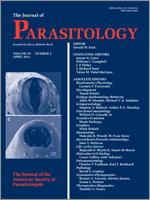The great white shark Carcharodon carcharias Linnaeus, 1758 is a versatile and fierce predator (and responsible for many shark attacks on humans). This apex predator feeds on a wide range of organisms including teleosts, other elasmobranchs, cephalopods, pinnipeds, and cetaceans. Although much is known about its diet, no trophic links have been empirically identified as being involved in the transmission of its tapeworm parasites. Recently, the use of molecular tools combined with phylogenetics has proven useful to identify larval and immature stages of marine tapeworms; utilization of the technique has been increasing rapidly. However, the usefulness of this approach remains limited by the availability of molecular data. Here, I employed gene sequence data from the D2 region of the large subunit of ribosomal DNA to link adults of the tapeworm Clistobothrium carcharodoni Dailey and Vogelbein, 1990 (Cestoda: Tetraphyllidea) to larvae for which sequence data for this gene are available. The sequences from the adult tapeworms were genetically identical (0% sequence divergence) to those available on GenBank for “SP” ‘small’ Scolex pleuronectis recovered from the striped dolphin (Stenella coeruleoalba) and Risso's dolphin (Grampus griseus). This study is the first to provide empirical evidence linking the trophic interaction between great white sharks and cetaceans as a definitive route for the successful transmission of a tetraphyllidean tapeworm. Using the intensity of infection data from this shark and from cetaceans as proxies for the extent of predation, I estimate that this individual shark would have consumed between 9 to 83 G. griseus, fresh, dead, or both, in its lifetime.
How to translate text using browser tools
1 April 2011
Insights Using a Molecular Approach Into the Life Cycle of a Tapeworm Infecting Great White Sharks
Haseeb S. Randhawa
ACCESS THE FULL ARTICLE

Journal of Parasitology
Vol. 97 • No. 2
April 2011
Vol. 97 • No. 2
April 2011




